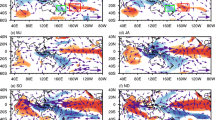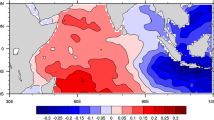Abstract
The evolution of sea surface temperature (SST) and thermocline (represented by 20 °C isotherm depth, D20) in the east equatorial Indian Ocean (EIO) associated with the Indian Ocean Dipole (IOD) years is studied for the period of 50 years from 1958 to 2007. A new IOD index based on combined anomalies of surface winds, D20 and SST over the equatorial Indian Ocean is defined to identify strong and weak IOD events. It is found that the evolution of strong IOD events is driven by ocean dynamics in the form of thermocline–SST coupling and is strongly interactive with the atmosphere, whereas the weak IOD events are mere response to surface winds without such dynamical coupling. The easterly wind anomalies extend up to the western equatorial Indian Ocean (WIO) during strong IOD years and support enhanced EIO air–sea interactions. On the other hand, the evolution of zonal wind anomalies is weak during the weak IOD years. Thermocline–SST coupling is robust in both EIO and WIO during strong IOD years, which is primarily responsible for the enhanced SST gradient, strong enough to establish anomalous Walker circulation within the Indian Ocean. The strong convection over the WIO associated with the Indian Ocean Walker cell triggers a secondary cell with subsidence over the African landmass. This double cell structure over the equatorial Indian Ocean is not reported before. Such double cell structure is not evident in weak IOD years and instead the convection over WIO extends up to African landmass. These are well supported by the spatial pattern of anomalous precipitable water during strong and weak IOD years. Strengthening of monsoon flow and local Hadley cell associated with strong IOD events enhances precipitation over the Indian subcontinent, whereas weak IOD years have less impact on the Indian summer monsoon circulation and rainfall. Analysis reveals that the EIO thermocline index and combined index could be potential predictors for the central Indian rainfall during summer.









Similar content being viewed by others
References
Allan NJ, Chambers D, Drosdowsky W, Hendon H, Latif M, Nicholls N, Smith I, Stone R, Tourre Y (2001) Is there an Indian Ocean Dipole, and is it independent of El Niño-Southern Oscillation? CLIVAR Exch 6:18–22
Annamalai H, Murtugudde R, Potemra J, Xie S-P, Liu P, Wang B (2003) Coupled dynamics over the Indian Ocean: spring initiation of the zonal mode. Deep Sea Res Part 2 50:2305–2330
Annamalai H, Liu P, Xie S-P (2005) Southwest Indian Ocean SST variability: its local effect and remote influence on Asian monsoons. J Clim 18:4150–4167
Ashok K, Guan Z, Yamagata T (2001) Impact of the Indian Ocean dipole on the relationship between the Indian monsoon rainfall and ENSO. Geophys Res Lett 28:4499–4502
Ashok K, Guan Z, Saji NH, Yamagata T (2004) Individual and combined influences of the ENSO and Indian Ocean Dipole on the Indian summer monsoon. J Clim 17:3141–3155
Behera SK, Krishnan R, Yamagata T (1999) Unusual ocean–atmosphere conditions in the tropical Indian Ocean during 1994. Geophys Res Lett 26:3001–3004
Bjerknes J (1969) Atmospheric teleconnections from the equatorial Pacific. Mon Weather Rev 97:163–172
Carton JA, Giese BS (2008) A reanalysis of ocean climate using Simple Ocean Data Assimilation (SODA). Month Weather Rev 136:2999–3017
Chowdary JS, Gnanaseelan C (2007) Basin wide warming of the Indian Ocean during El Niño and Indian Ocean dipole years. Int J Climatol 27:1421–1438. doi:10.1002/joc.1482
Dee DP et al (2011) The ERA-Interim reanalysis: configuration and performance of the data assimilation system. Q J R Meteorol Soc 137:553–597
Dommenget D (2011) An objective analysis of the observed spatial structure of the tropical Indian Ocean SST variability. Clim Dyn 36:2129–2145
Du Y, Cai W, Wu Y (2012) A new type of the Indian Ocean Dipole since the mid-1970s. J Clim 26:959–972
Gadgil S, Vinayachandran PN, Francis PA, Gadgil S (2004) Extremes of the Indian summer monsoon rainfall, ENSO and equatorial Indian Ocean oscillation. Geophys Res Lett 31:L12213. doi:10.1029/2004GL019733
Guan Z, Yamagata T (2003) The unusual summer of 1994 in East Asia: IOD teleconnections. Geophys Res Lett 30:1544. doi:10.1029/2002GL016831
Izumo T, de Boyer Montegut C, Luo JJ, Behera SK, Masson S, Yamagata T (2008) The role of the western Arabian Sea upwelling in Indian monsoon rainfall variability. J Clim 21:5603–5623
Li T, Wang B, Chang C-P, Zhang Y (2003) A theory for the Indian Ocean Dipole–zonal mode. J Atmos Sci 60:2119–2135
Meyers G, McIntosh P, Pigot L, Pook M (2007) The years of El Niño, La Niña, and interactions with the tropical Indian Ocean. J Clim 20:2872–2880. doi:10.1175/JCLI4152.1
Murtugudde R, McCreary JP, Busalacchi AJ (2000) Oceanic processes associated with anomalous events in the Indian Ocean with relevance to 1997–1998. J Geophys Res 105(C2):3295–3306. doi:10.1029/1999JC900294
Praveen Kumar B, Vialard J, Lengaigne M, Murty VSN, McPhaden MJ (2012) TropFlux: air–sea fluxes for the global tropical oceans—description and evaluation. Clim Dyn 38:1521–1543. doi:10.1007/s00382-011-1115-0
Saji NH, Yamagata T (2003) Possible impacts of Indian Ocean dipole mode events on global climate. Clim Res 25:151–169. doi:10.3354/cr025151
Saji NH, Goswami BN, Vinayachandran PN, Yamagata T (1999) A dipole mode in the tropical Indian Ocean. Nature 401:360–363. doi:10.1038/43854
Spencer H, Sutton RT, Slingo JM, Roberts JM, Black E (2005) The Indian Ocean climate and dipole variability in the Hadley centre coupled GCMs. J Clim 18:2286–2307
Susanto RD, Gordon AL, Zheng Q (2001) Upwelling along the coast of Java and Sumatra and its relation to ENSO. Geophys Res Lett 28(8):1599–1602
Thompson B, Gnanaseelan C, Salvekar PS (2006) Variability in the Indian Ocean circulation and salinity and its impact on SST anomalies during dipole events. J Mar Res 64:853–880. doi:10.1357/002224006779698350
Thompson B, Gnanaseelan C, Parekh A, Salvekar PS (2009) A model study on oceanic processes during the Indian Ocean Dipole termination. Meteorol Atmos Phys 105:17–27. doi:10.1007/s00703-009-0033-8
Tokinaga H, Tanimoto Y (2004) Seasonal transition of SST anomalies in the tropical Indian Ocean during El Niño and Indian Ocean dipole years. J Meteorol Soc Jpn 82:1007–1018. doi:10.2151/jmsj.2004.1007
Uppala SM et al (2005) The ERA-40 re-analysis. Q J R Meteorol Soc 131:2961–3012. doi:10.1256/qj.04.176
Vinayachandran PN, Saji NH, Yamagata T (1999) Response of the equatorial Indian Ocean to an unusual wind event during 1994. Geophys Res Lett 26:1613–1616. doi:10.1029/1999GL900179
Webster PJ, Moore AW, Loschnigg JP, Leben RR (1999) Coupled ocean atmosphere dynamics in the Indian Ocean during 1997–1998. Nature 401:356–360. doi:10.1038/43848
Yamagata T, Behera SK, Luo JJ, Masson S, Jury MR, Rao SA (2004) Coupled ocean–atmosphere variability in the tropical Indian Ocean. In: Wang C, Xie SP, Carton JA (eds) Earth climate: the ocean–atmosphere interaction. Geophys Monogr Ser 147:189–211. AGU, Washington. doi:10.1029/147GM12
Yatagai A, Kamiguchi K, Arakawa O, Hamada A, Yasutomi N, Kitoh A (2012) APHRODITE: constructing a long-term daily gridded precipitation dataset for Asia based on a dense network of rain gauges. Bull Am Meteorol Soc 93:1401–1415
Acknowledgments
The authors thank Prof. B.N. Goswami, Director, IITM, Ministry of Earth Sciences (MoES), India and Space Applications Center, Ahmedabad for support. We thank the anonymous reviewers for their comments and suggestions which helped us to improve the manuscript considerably.
Author information
Authors and Affiliations
Corresponding author
Rights and permissions
About this article
Cite this article
Deshpande, A., Chowdary, J.S. & Gnanaseelan, C. Role of thermocline–SST coupling in the evolution of IOD events and their regional impacts. Clim Dyn 43, 163–174 (2014). https://doi.org/10.1007/s00382-013-1879-5
Received:
Accepted:
Published:
Issue Date:
DOI: https://doi.org/10.1007/s00382-013-1879-5




